SEO Branding Tips: How SEO Can Build Your Brand
Key Takeaways
- Published media shapes brand perception by enhancing audience recall and association with specific attributes.
- SEO boosts brand visibility to new audiences through optimized content, improving brand awareness.
- SEO's ability to increase visibility on search engines can lead to attracting more attention from users who tend to focus on results from the first search page.
You probably don’t realize it, but your published media contributes to people’s perception of your brand. It increases how the audience you’ve reached remembers you and what they remember you for.
If you create a lot of videos, they will remember you as the brand that makes a lot of videos. If you mix SEO with an effective social media content (and promotion) strategy, they’ll recognize you as the brand with great content and distribution tactics. So you can find them everywhere.
However, beyond the perceptions of marketers and a few target audiences, your visibility on search engines influences the success of your brand. Through optimized content, SEO amplifies your visibility to new audiences to increase brand awareness.
But beyond optimized content, here are other ways SEO gives you autonomy over your brand’s visibility.
How SEO Builds Your Brand
Building your brand is the only way to get the word out about what you’re doing as a business. While you can maximize social media marketing or referral traffic, SEO provides long-term (and consistent) results, which is why it is one of the most preferred content marketing options. We know this because we have helped companies achieve results. SEO:
1. Increases Visibility
Every marketer hopes to create content that ranks organically for their target keywords. Higher search engine rankings mean you get more exposure for your brand. And the more your website appears on the first page of search results for relevant keywords, the better.
This visibility attracts more attention from users who usually don’t go beyond the first page of search results.
Take a look at the search results for “backlink building strategy.” Semrush and Backlinko are among the top three results.

Look at another search result on “how to get backlinks”; Semrush and Backlinko are still among the ranking pages.

Naturally, these brands will register in your mind the next time you have a query about backlink building strategy and the tools that can help you do it effectively.
These brands get to maintain top spots for these queries because they create optimized content for keywords that target their audiences and increase their visibility to users who have never heard about them before.
2. Attracts Traffic from Ideal Customers
It’s one thing for your content to pop up on search results pages; it’s another for them to attract the right audience.
The right traffic is the kind that brings you closer to your specific audience through content pieces that convert them based on the goal of that content.
To draw in the right crowd, you need to optimize for specific keywords and phrases that align with the queries of your intended audience.
For instance, a sustainable clothing company with keywords like “eco-friendly fashion,” “ethical clothing,” or “sustainable wardrobe” will naturally appeal to consumers actively looking for eco-friendly brands.
But aside from optimizing for these top-of-the-funnel keywords (which can attract just about any fan of sustainable clothing), optimizing for “sustainable t-shirts women’s” or “eco-friendly t-shirt bags” is a better way to be visible to users with the specific intent to buy.
This logic is why Baclinko put more effort into ranking for the keyword “b2b content marketing strategy” over “content marketing, ” a broader term that may not attract its target audiences.
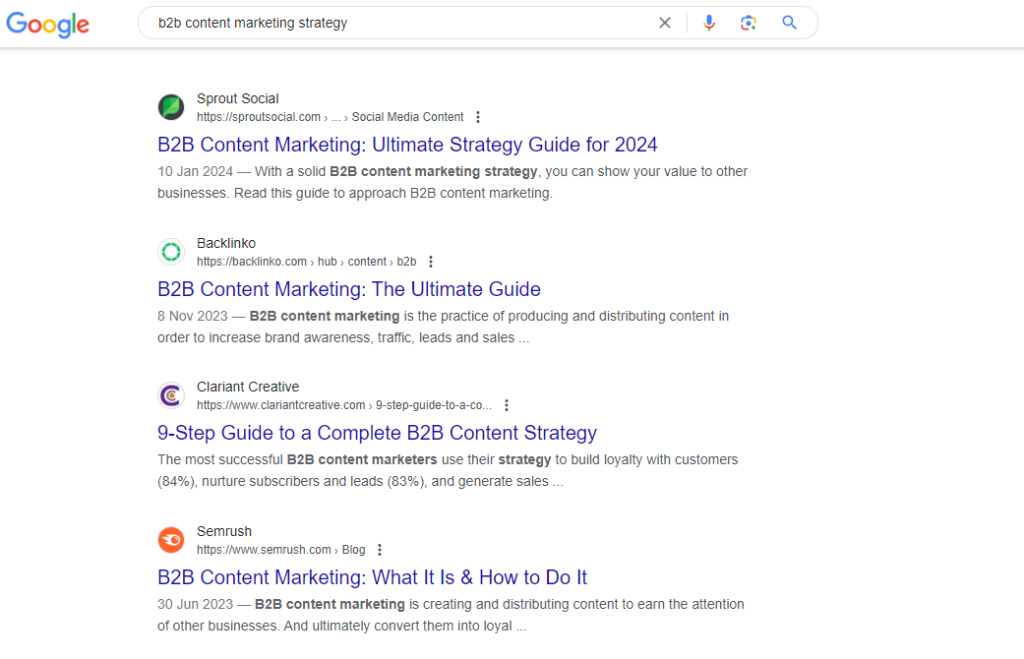
In other words, ranking for super specific long tail keywords often increases your chances of appearing on the result pages of the specific audiences that will be interested in your products or services. This makes every content relevant to bottom-line revenue.
It also means that while SEO content increases brand visibility, you can be strategic with your keywords to be more visible to audiences that can convert faster because your content/brand is exactly what they need.
But how do you make your content exactly what they need, and how does SEO help?
3. Helps in Creating Quality Content
Search engines value high-quality content, i.e., content that goes beyond embedding keywords to rank on the first results page.
Search engines like Google prioritize content that meets search intent and provides relevant answers to users’ queries. This way, your content anticipates users’ pain points when they enter the query, becoming the right content for them.
Quality content also typically includes quality visuals. It includes using images, infographics, screenshots, and videos to make the piece more memorable and helpful for readers.
This way, readers can get contextual information about a passage of the content, just like I did with the screenshots on Backlinko and Semrush.
Quality content also approaches content from a unique angle, i.e., the content has a unique perspective and provides more value than the ones on the result page. This way, the content is more user- and value-focused without regurgitating what exists in search results.
Quality content also meets E-E-A-T guidelines— it demonstrates the writer’s expertise, experience, and authoritativeness and inspires trust.
There are other metrics for measuring quality content, but these are highly important for every piece of content you produce.
Content that engages readers signals to Google that your content is relevant to their queries. And the more time users spend on your web pages, the more value those pages have on Google.
This means your page will rank higher and be exposed to new audiences searching for the same content. Publishing high-quality content also builds trust because you’ll become a go-to source for any query your users have for their industry.
This is why branded search terms exist, for example, “highervisibility: how to improve SEO”
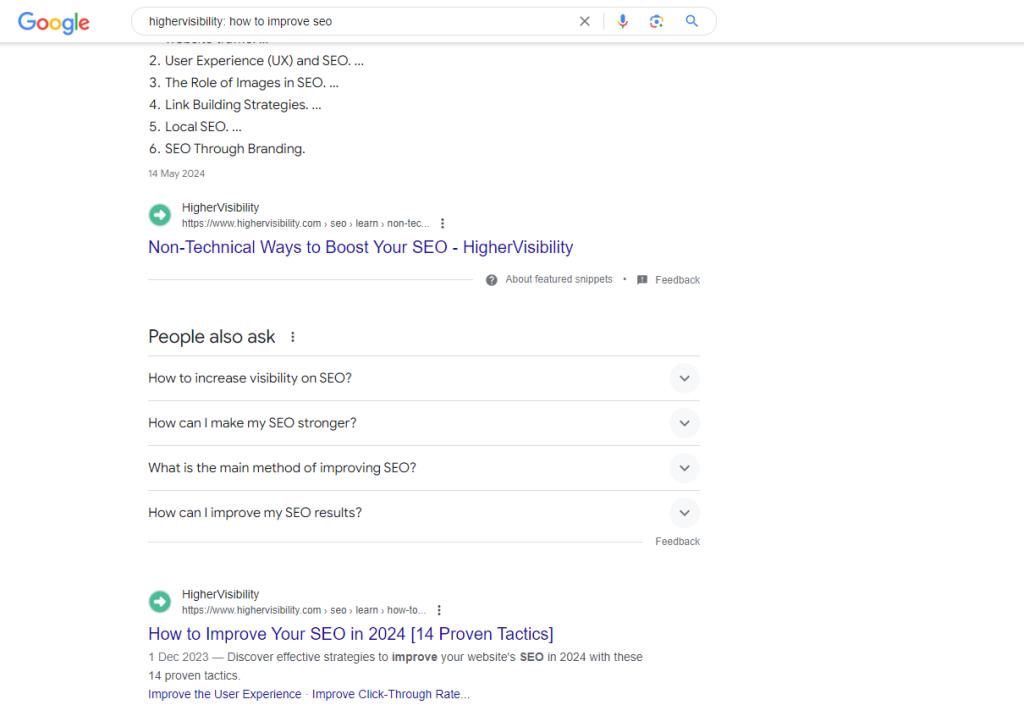
OR “fair indigo t-shirts”
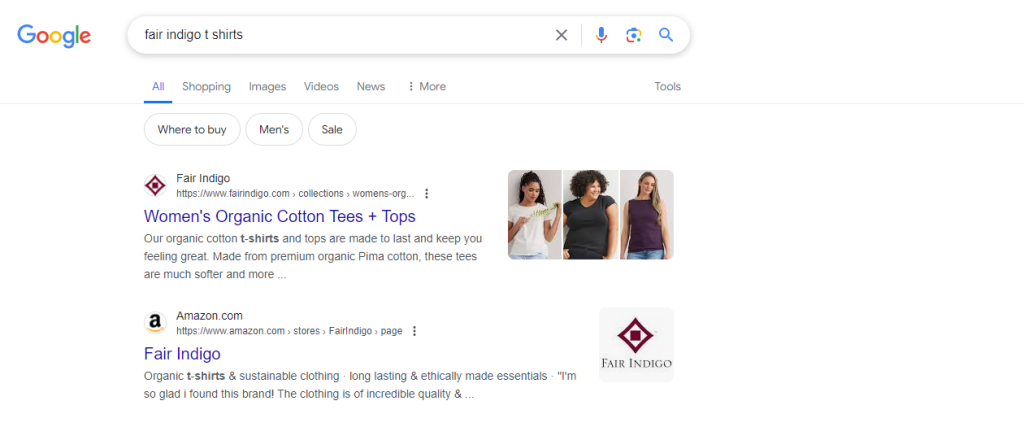
4. Positive User Experience to Strengthen Brand Perception:
Let’s paint a quick scenario:
You visit a website that takes forever to load. And when it does, it has a confusing layout and doesn’t display correctly on your phone.
When you try to expand an image, it moves to another side of the screen, and you can’t navigate it properly.
This is a typical example of a negative user experience. And no matter how great your products/services or content are, a negative experience can quickly tarnish your brand image.
On the flip side, a well-optimized website that loads quickly is easy to navigate and looks great on any device. It’s the kind of website you want to visit again because every button works, and you don’t need to use your desktop browser to see a CTA button or a product image hidden in a corner.
This kind of experience is associated with ease, and it’ll make users believe your brand prioritizes user experience as much as it pays attention to its products/services.
This emphasis on user experience influences technical SEO, which focuses on the features on your website that may affect the visibility of your content and the user experience while navigating your site.
So, the more stable your technical SEO is, the better for brand awareness and visibility on search engine result pages.
5. Local SEO for Community Brand Awareness
Although SEO is primarily associated with its ability to reach a global audience, it also amplifies brand visibility for brick-and-mortar stores. Here’s what I mean:
According to research, 4 in 5 consumers conduct searches with local intent. And 76% of consumers with “near me” searches visit a business within 24 hours.
This means that, in addition to having a store where people can see you, having a digital presence can increase foot traffic to that store.
The rise of mobile search and voice assistants has also led to an explosion of “near me” searches. Users now type “coffee shops near me,” “best pizza in (city name),” or “hair salon near me” on search engines and are provided relevant results.
So, having an online presence via local SEO can contribute to brand awareness and bring your business to the forefront of these hyper-local searches.
Here’s an example for the query “best pizza in Albany”:
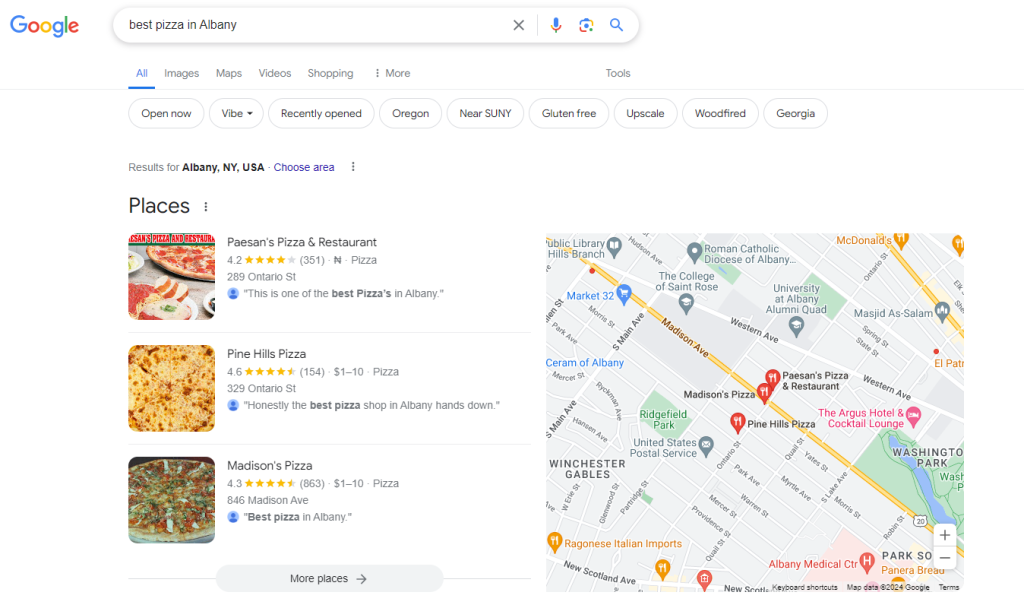
Aside from optimizing for local SEO, having a Google My Business account also contributes to your visibility on search engines. An optimized Google My Business account can get an average of 80 to 300 quality clicks and around 48 calls monthly. These are clicks and calls that can lead to repeat sales.
So, optimizing your GMB profile with information such as your address, phone number, hours of operation, photos, and customer reviews will make it easy for new customers to find you. It’ll also make it easy for users to remember you when they need a product or service you offer.
Now, how can you use SEO to build your brand?
How to Use SEO to Build Your Brand
Building your brand through SEO means being intentional about your content strategy and how you expand your digital footprint online. To get started or enhance an existing process, do these:
1. Develop a Brand Keyword Strategy
This means identifying and targeting the keywords and phrases that reflect what your target audience is looking for. But you need to have already nailed down two things:
- Your target audience. Clearly define who they are without reducing them to fictional characters. Consider using important questions like “What is the pain point we solved with our product/service?”
“Who are the people with these pain points?”
Why do they need this specific pain point solved?”
“How important is it to them— does it make their work smoother or make them feel good about what they wear or how they’re perceived in public?”
“Again, who are they? Parents, teenagers, or widows?”
If you’re in the B2B industry, figure out their role and, more importantly, how educated they are about their pain points.”
To answer some of these questions, you may need to speak with actual customers (or past customers) to know who they are, why they need your product/services, and how they discovered you.
Many Slack users didn’t need to discard email when Slack rose to prominence. However, some needed to integrate the product with other software, such as project management and productivity tools.
So, if Slack had said their buyer persona is “everyone in corporate or business,” they’d be casting a wide net and would waste a lot of marketing dollars. Aside from that, they will not market to solopreneurs, remote teams, freelancers, and other people who use their product.
- Brand voice. What makes your brand unique?
What tone and messaging do you want to convey? Do you want to be casual (especially in B2C) or a bit corporate (especially if you own a developer product for high-level executives in tech startups)?
To present a united voice, your brand voice should be consistent across all communication channels (website, socials, email).
After understanding who your target audience is and you’ve developed a brand voice, research and select your keywords. Here’s an overview:
- Researching and selecting keywords may start with brainstorming keywords relevant to your products and services. This is where you think about how people articulate the pain points you solve when they type on Google.
Then, use keyword research tools to expand your list. Enter your keyword on these tools to identify keywords with high intent and low competition. You can also conduct competitor analysis to know the keywords competitors are ranking for— which you can optimize for.
Then, include a mix of broad terms (like “sustainable fashion” or “organic skincare”) and more specific, long-tail keywords (like “eco-friendly yoga pants” or “cruelty-free makeup”). Broad terms can help you reach a wider audience, while long-tail keywords with less competition can attract more qualified traffic.
Finally, include branded keywords (your brand name and variations) in your content strategy. These are important for building brand awareness and capturing users already familiar with your brand—for example, (brand name) organic cotton t-shirts.
Read this resource on keyword research and how to create an efficient content strategy.
2. Optimize Your Website for Technical SEO:
Technical SEO is everything in the backend that makes your content visible (or affects its visibility). It’s about improving your website so that search engines can crawl (find), understand, and store (index) it.
We’ve created detailed resources.
Here: Technical SEO: Why is It Important?
Here: Non-Technical Ways to Boost Your SEO
And here: How to Tell if Your SEO is Working.
Technical SEO helps you ensure your website is optimized for user experience in different ways.
The key pillars of technical SEO for brand awareness include:
- Website Structure: Your website should be organized like a library, with clear categories and internally linked pages. This helps users find information easily (just like we embed links in texts on this page) and makes it easier for search engines to crawl and index your content.
- Mobile Optimization: Ensuring your website is responsive and adapts flawlessly to different screen sizes is non-negotiable today. Google prioritizes mobile-friendly sites in its search results, and a poor mobile experience can drive away potential customers.
- Page Speed Optimization: No one likes a slow website. A delay of even a few seconds can lead to high bounce rates and lost conversions. Optimize your site’s code, images, and server settings to ensure lightning-fast loading times.
- Site Security (HTTPS): An SSL certificate encrypts sensitive user data and signals to search engines that your site is secure and trustworthy. It’s a must-have.
- Structured Data (Schema Markup): This is a way to provide search engines with additional context about your content, allowing them to display rich snippets in search results (e.g., star ratings, product prices, event details). This can significantly improve your click-through rate.
- XML Sitemaps: An XML sitemap is a roadmap of your website that helps search engines discover and index all your pages. Ensuring that all your content is visible in search results is essential.
- Robots.txt: This file tells search engines which pages or sections of your website should not be crawled or indexed. It helps prevent duplicate content and prioritizes your most important pages.
- Canonical Tags: These tags help prevent duplicate content issues by specifying the preferred version of a page that should be indexed.
- Image Optimization: Optimizing your images by compressing them and using descriptive alt text can improve your page load speed and make your content more accessible to visually impaired users.
- Internal Linking: Strategically linking between your website’s pages helps users navigate your site and can also help search engines understand the relationship between different pages and topics.
You may ask, how does technical SEO contribute to brand awareness?
Without strong technical SEO, search engines may be unable to crawl or store your content. This means your pages won’t rank for your targeted keywords because you’re invisible on Google.
However, with strong technical SEO, Google will crawl (find), index (store), and rank your content in search results. Because of the positive user experience, you’ll also be able to attract relevant traffic and keep them engaged on your page.
3. Build High-Quality Backlinks
Backlinks are like votes of confidence from other websites. Each link tells search engines, “This brand produces valuable, relevant, and trustworthy content.”
The more high-quality votes you receive, the higher your domain ranking will be, which means your brand will appear more on results pages because Google trusts your content.
There are several ways to earn backlinks. You can start by creating quality content to which others in your industry want to link. For example, a major tech news site like The Verge may see your whitepaper on the future of artificial intelligence and feature it in their story around AI.
If you’re in B2C, a fashion outlet like Vogue or an interior decor magazine like Pretty Little Home links to one of your high-converting content on a trendy topic. These will earn you quality backlinks to improve the authority of your website.
You can also reach out to reputable websites in your industry for a backlink. You can do this through PR with other journalists or guest posting on their platforms with the goal of embedding a link to one of your pages in the article.
Our co-founder guest posts regularly on Search Engine Land, an industry-leading publication on content marketing.
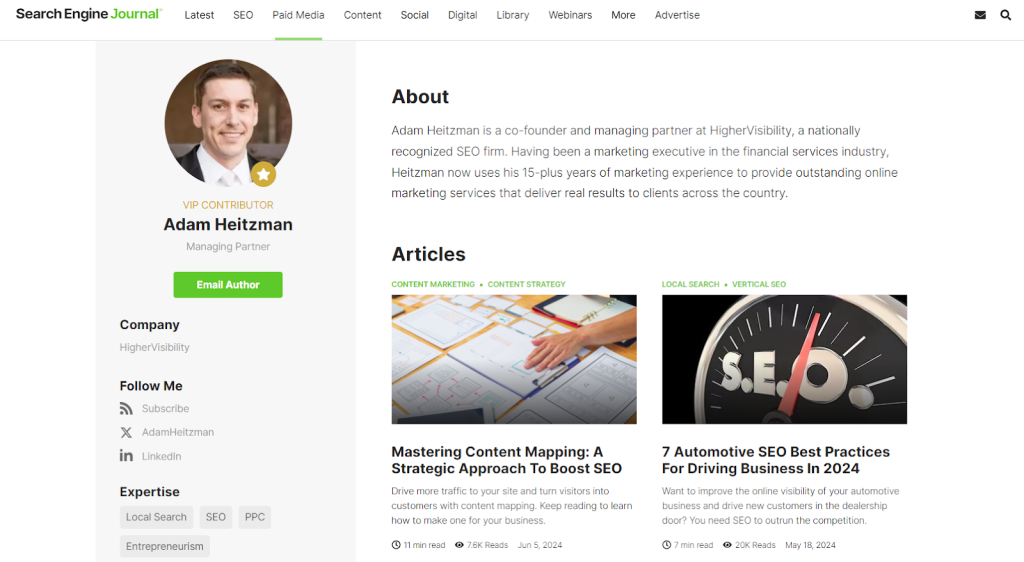
While the goal is to contribute to content marketing topics, visibility on industry-leading blogs contributes to backlink building. How? If we’ve elaborated on a subject on our blog, we can refer readers to our blog to uncover more about the topic.
4. Optimize for Local Search
Optimize for local search if your business caters to a specific geographic area or has physical locations. Optimizing for local search helps your brand appear in search results when potential customers in your vicinity search for products or services like yours.
To get started, use Google My Business (GMB). Your GMB listing is your brand’s online storefront and the first impression potential customers have of your business, so make it count by:
- Claiming and verifying your listing to take control of the information displayed.
- Completing your profile by filling in all relevant information, including your business name, address, phone number, website, hours of operation, and category.
- Adding high-quality photos and videos to showcase your products, services, team, and physical location.
- Encouraging customer reviews by actively soliciting reviews from satisfied customers to build trust and credibility in your brand.
- Posting updates and offers through news, promotions, events, and other relevant updates to keep your listing fresh and engaging.
Learn how to optimize your Google My Business here.
You should also consider local citations. These are online mentions of your business name, address, and phone number (NAP). These citations can appear on directories, review sites, social media platforms, and other websites, so you must be consistent across platforms to succeed in your local SEO efforts. You can do this by:
- Ensuring NAP Consistency: Double-check that your business information is consistent across all online platforms. Discrepancies can confuse search engines and hurt your local rankings.
- Submit to Relevant Directories: List your business on major directories like Yelp, Yellow Pages, and industry-specific directories relevant to your niche.
- Monitor and Update Citations: Regularly audit your citations to ensure accuracy and make any necessary updates.
Learn more about how to dominate local SEO here.
And learn How to Handle Local SEO Without a Physical Address.
Final Words
Your business is an ambassador of your brand, and SEO can help you achieve your goals in terms of exposure and revenue. If you need help getting started with your SEO, contact one of our experts. If you’re unsure if you need our services, learn more about our holistic approach to SEO here and how we can help your business grow.
